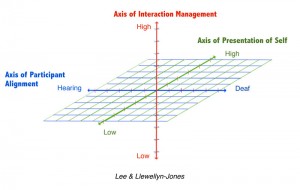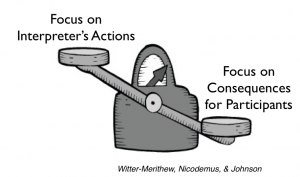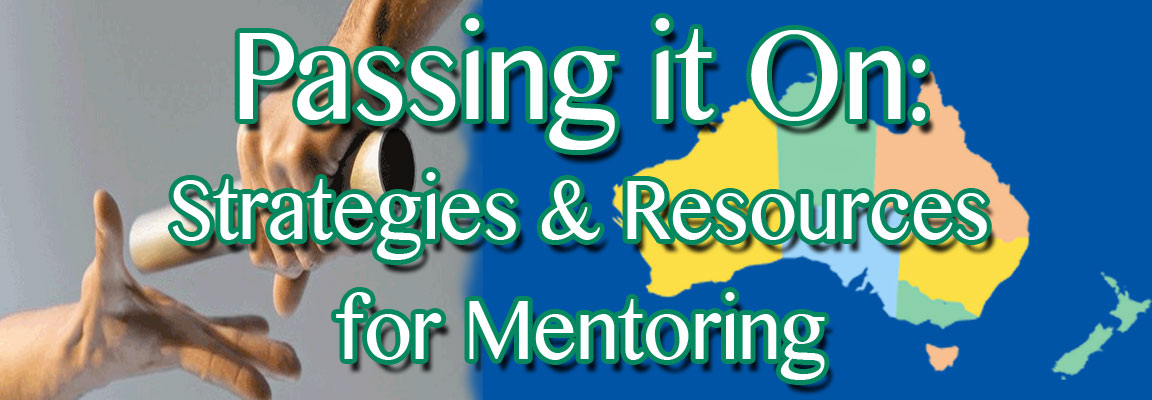
30 January 2017
Perth, Western Australia
Mentoring is an important process for nurturing the professional development of interpreters. This interactive workshop will give you a chance to experience best practices in mentoring in the United States, including approaches to peer dialogue, Vygotskyan framework for mentoring activities, resources for mentorship, case conferencing, and technologies for mentoring via distance. Participants will also have on-going access to professional development related to mentoring.
Workshop Presentation
Click on the buttons below to access resources from the workshop.
Workshop Resources
Workshop Resources
Each of the titles in the list below is a link. When you click on the title, it will reveal a series of resources contained in that category.
Mentoring Resources
Narrative Resources
Here are resources related to Narrative Skills – as some towards understanding other discourse genres as well.
The clip of the Coyote
Debbie’s Rendition of the Coyote Clip
A Clip of Quidditch
Debbie’s Rendition
Other Video Resources
- Goats, Trolls & Numbskulls: A Middle School Lecture on Folklore Genres
- Navigating Discourse Genres:? Parallel Texts in American Sign Language and English on Canoeing in the Boundary Waters
Posted in: "Interpreting Literature" Resources, In Service to Literacy, Mentoring Resources
Social Literacy
Social Literacy
Resources from the field of Speech and Language Pathology can be extremely useful in developing these social literacy skills. You may nave a Speech/Language clinician who is a part of the team who you can work with and get other ideas for how to support this work. (In the same way that you might tutor a student with the support of a teacher, you may work on social interaction with the support of the a speech/language clinician.)
Another suggestion for developing social literacy is including the student as an assistant teacher in ASL instruction for their peers. For some students who are hard of hearing or use a cochlear implant, it may develop a higher regard for the use of sign language and provide a greater benefit for having an interpreter as part of the educational team. Additionally, it can help provide a role for the student that needs to focus on taking turns within the activities and clue students in to the ways that people need to wait for their turn.
Posted in: "Interpreting Literature" Resources, In Service to Literacy, Mentoring Resources
BICS & CALP/Academic ASL
Why Academic ASL Matters to Sign Language Interpreters
This is a presentation by Dr. Ben Bahan at StreetLeverage in Fremont, California in 2016. The video of the presentation is presented as well as an English translation. Though it takes more time to watch the ASL, I would recommend it is worth it to see such an excellent example of Academic ASL.
Dr. Bahan refers to the work of James Gee who is a social linguist and literary theorist who focuses on “Discourse” – differentiating between the primary Discourse a person learns in their family of origin and the “secondary Discourse” they learn in other settings. (Which connects to the idea of BICS/CALP described below. Read more about Gee’s work in his article “What is Literacy?”
Importance of Early Exposure to ASL
Henner et. al. American Sign Language Syntax and Analogical Reasoning Skills Are Influenced by Early Acquisition and Age of Entry to Signing Schools for the Deaf. Front. Psychol., 26 December 2016 | https://doi.org/10.3389/fpsyg.2016.01982
This article shares research about the impact of the age of acquisition of ASL for students. Importantly, it points out that early exposure to ASL is a benefit for both signing skills, but also cognitive development – which supports the acqusition of speech skills as well.
BICS/CALP
More information about Basic Interpersonal Communication Skills & Cognitive Academic Language Proficiency
- An article on BICS/CALP from the field of teaching English as a second language
- Information from Wikipedia on Professor Jim Cummins & BICS/CALP
- An ASL presentation of Kindergarten Readiness for Deaf students on ASLized.org
Learning English as a Second Language
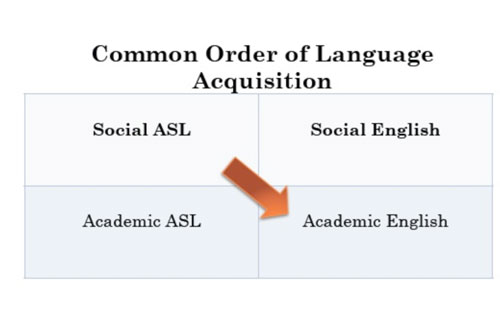
The bottom graphic demonstrates what is often attempted for Deaf and Hard of Hearing students – which in part explains such poor results.
Academic ASL
 A blog supporting using ASL to developing BICS & CALP
A blog supporting using ASL to developing BICS & CALP- Resources from Gallaudet on ASL Composition
- ASL in Academics Lecture Series at Gallaudet
- Deaf Studies Digital Journal at Gallaudet University (The first journal published in ASL.)
- ASLized.org: This is a site designed to the promotion of ASL and provides ASL texts in a variety of genres.
A Video presentation of Dr. Raychelle Harris on Academic Discourse in English and ASL (Provided in ASL with English captioning)
The kick off lecture for the ASL in Academics Lecture Series
Use of Academic ASL in a High School Math Class
See the Mirrored Math resource.
Answers to Math Questions from Veditz
Posted in: "Interpreting Literature" Resources, "Putting FS on the Map" Resources, "TIPS-Light" Resources, In Service to Literacy, Mentoring Resources, Moving toward Best Practice, Sense of Place, Swiss Army Knife Tools
Classroom Lessons & Interpretations
A Lesson on Shapes
Sample interpretation of the Lesson
Doug’s reflection on the interpretation
First of all, for the context of the interpretation: I had seen the video once before all the way through and had helped prepare the lesson so I was familiar with the pattern blocks and their usage in a geometry lesson. I have also interpreted similar lessons in an actual classroom, so that familiarity was of great benefit for feeling ready. In doing my analysis, I watched it with no audio so that I could focus in on my own work, without the interference from the spoken English.
In thinking about the features that I saw in my own work sample, I have a couple of large overarching items which stand out – one focused on classroom management and interaction between teacher and students. The other focused on the content which is being taught.
In terms of classroom management, as we have been discussing in the course, the IRE structure is very present in this interaction and I was striving to try to make it clear of how. When it started, I felt that I was a little bit stuck in first gear. Working too fast to try to fit everything in. Some of my initial fingerspelling was too rapid (which we’ll talk more about in the next module) mostly based on my trying to manage that interaction and be sure that I was able to get in the teacher’s evaluation. There was some repetition on the teacher’s part, and I wonder, in hind sight, if it would have been better for me to reduce some of the repetition to slow things down at first.
In terms of the content of the discourse, the most significant piece for me was effectively using space to convey the ideas, both in terms of the process of creating patterns and in terms of discussing the geometric shapes. As mentioned before, one advantage I have is my experience interpreting in classrooms where pattern blocks are used, so I was able to quickly visualize both the shapes themselves, and the creative ways that students use them.
I also tried to have a variety of different spatial maps in a variety of orientations. While in class, I would have relied a lot more on the “Vanna White” model of interpreting i.e. pointing at the overhead to show the shape, without that, I felt the need to re-create the shape. It made for a more busy interpretation… (perhaps I was in second gear by then) but I think that the use of space really helped. For example, on the description of the regular hexagon, I think the repetition in the interpretation of the sign “equal” in all the same spots where I had showed “sides” was a relatively effective way to show that concept.
One spatial construct that I wish I would have done differently was at the end, when she gave directions that students could work as partners to create a joint pattern or as individuals to create separate patterns, my interpretation of both options occurred on my non-dominant side in the same spatial set-up. Given that this was a contrast – I think it would have been more effective for the spatial set-up to happen on the left and the right so the students would have seen more clearly that they had two distinct options to choose from.
There is much more in this work to consider, but for the purposes of discourse, I think those two main points are the ones which are most important to reflect upon.
Lecture on the Neuron
Extended Lecture on Neuron
Doug’s Interpretation
Example of Nigel Howard talking about communication through the nervous system
This was filmed for another project, but is an example of a very skilled Certified Deaf interpreter who is an expert in health care talking about similar physiological processes.
Posted in: In Service to Literacy, Mentoring Resources
Educational Interpreting
Resources Related to Educational Interpreting
The National Association of Interpreters in Education

The National Association of Interpreters in Education (NAIE) is a professional organization for interpreters in educational settings established in 2016. http://naiedu.org/
 More than Meets the Eye: Revealing the Complexities of an Interpreted Education
More than Meets the Eye: Revealing the Complexities of an Interpreted Education
by Melissa B. Smith
http://gupress.gallaudet.edu/bookpage/MTMEbookpage.html
View the Ph.D. Dissertation this book is based on here.
Dr. Smith did a lecture at Gallaudet University on this topic.
You can see all of the presentations archived by Gallaudet University Regional Interpreter Education Center here.
Understanding the Impact of Interpretability in Mainstream Classrooms
This chapter by Betsy Winston lays out the limitations for rigid understandings of interpreting in classroom settings.
Winston, B. 2004. “Interpretability and Accessibility of Mainstream Classrooms,” In Educational Interpreting: How it Can Succeed. Gallaudet University Press. See the article.
Articles about Educational Interpreting
New Paradigms in the Interpreted Classroom: An article written by Doug Bowen-Bailey for the RID Views -(in press August 2014)
Perspectives from Gina Oliva
Dr. Oliva is the author of “Alone in the Mainstream” sharing her experience as an “only” going through mainstreamed settings – as well as some of her research about other deaf people who went through the mainstream in a similar way.
- Sign Language Interpreters in Mainstream Classrooms: Heartbroken and Gagged
An article on Street Leverage. Check it out. - K-12 Interpreters: A Call to Arms for Sign Language Interpreter Programs
An article on StreetLeverage. Check it out.
Determining a Student’s Readiness to Successfully Use Interpreting Services
This is an article from Cindy Huff, a teacher of the Deaf/Hard of Hearing, about a framework for assessing if students are at a developmental level appropriate for benefiting from an interpreted education.
Language Acquisition
The link below has a presentation in ASL about the Common Errors of Young Children Acquiring Sign Language, helpful information in seeing what is normal language development.
Providing Access: New Roles for Educational Interpreters
By Bernhardt E. Jones, Ed.D., C.S.C.
Originally published in the RID VIEWS
Conflicts can, and do, occur when it is unclear as to the interpreter’s role at any given time. This function changes during the day, especially in the lower grades. I am suggesting (as has Winston) that the title, “educational interpreter” is too narrow, and, in fact, this position is a multi-faceted responsibility. If this is true, how do we separate the roles? How do we define what it is that we do and when?
A year ago Winston (Views) did a fine job in delineating educational interpreting responsibilities into three roles: interpreting, tutoring and aiding. Since then, Winston has discussed the notion that consulting is also a role that educational interpreters play. Consulting may be a new area that you had not considered before. But, think about all the times you have given your input in the school situation. How many times have you talked to parents? How many times have you explained “deafness” to others in the school? to students? to administrators? to regular education teachers? You may find that this list is long. Go to the dictionary or, better, go to the Web and search the word, “consulting” or “consultant” and see what you find. Do you fit into this definition during part of the time you are working in the school setting?
The public school educational interpreter is viewed quite often as a paraprofessional and, in fact, is categorized that way in many states. However, we can make the case that, although the interpreter does perform many of the duties of the paraprofessional, she/he also performs a duty that is quite different and requires separate and distinct knowledge and skills: interpreting itself. Are we not, then, more than an educational interpreter? Might we be, to use a term that Winston has expressed, an “Accessibility Specialist?” I don’t want to confuse the issue with additional terms for us, but think about the variety of tasks you perform. Perhaps we are not “just the interpreter,”but we are more than the interpreter.
Take a look at your day (or week or month, if you would like). Make a list of all the duties you perform. Try to think of everything that happens in your job. What do you do? How long do you do it? Make the list as long and comprehensive as you can. You should have a collection of everything you do. You may be surprised to see that you do quite a bit for the school and the students (both deaf/hard of hearing and hearing).
The Windmill Model
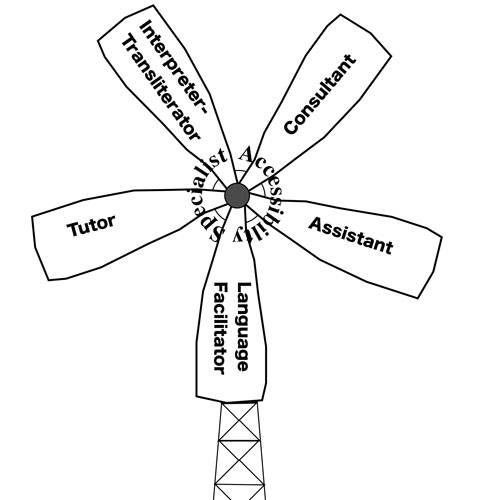
Note: The graphic has been updated since the article was written so it does not perfectly correspond to the article.
The next step is to draw your own windmill and categorize the duties/tasks that you have listed. Interpreting will include anything you do in the role of an interpreter. Tutoring will include all the tasks you do within that context. Aiding is a large and varied area or responsibility. Think of all the things you do in an aiding capacity. As discussed above, consulting is also an important role of the educational interpreter.
Isn’t this appropriate? A windmill spins in the wind and must be flexible (accommodating) in order to operate effectively and efficiently. If one of the blades is broken or damaged, the windmill will not operate properly. Are we like that?
I suggest that we are. With this model we can delineate our roles. When we are able to do that, we can better understand why dilemmas cause conflict. Conflict arises when we are not sure on which blade to categorize our dilemma. We are better able to handle conflict if we know the rules by which to address the conflict. When conflict arises, we know where it fits and, therefore, we know how to respond (how to “spin” our windmill). [I guess it depends upon who is blowing on our windmill.] The blades of the windmill can be viewed as contexts. When we know the contexts, we know the rules. This is where the Code of Ethics has caused us concerns. When applied to the interpreting blade (role, context) of the model, it is easy to understand the importance of the Code and to adhere to its principles. When we apply those same criteria to the other blades (roles), it becomes cloudy and appears to conflict with the role. The problem is compounded if other professionals do not know our contexts and/or confuse our contexts (roles, blades). We then can apply the “educating others about our role(s)” principle of the Code by explaining our contexts and the roles to others on the educational team. The other members of the educational team will not realize this by themselves. We have a professional obligation to educate our fellow professionals. By doing so, we will be viewed as professionals.
This is only the beginning. When we understand which role we are working within, we can start addressing bigger questions in our field. These questions might involve questions of interpretability in the classroom, accessibility to content, an interpreted education. These questions impact our windmill and, therefore services to students who are deaf and hard of hearing.
Information about the Educational Interpreter Performance Assessment
This site provides information both about the test and about the expectations for interpreters working in educational settings. classroominterpreting.org
Guides for Classroom Interpreting for Parents, Professionals, and Students
Dr. Brenda Schick, the co-creator of the EIPA, along with Boys Town, created a series of guides for the Laurent Clerc National Deaf Education Center.
Training in Interpreting Public Schools (TIPS)
TASK12: This is the organization that led to the development of the Training in Public Schools (TIPS) module. The project serves 14 states and provides both training and assessment with the EIPA.
Post-Secondary & Transition Resources:
The Minnesota Transition Guide for Teachers of Deaf/Hard of Hearing was created as a pilot project for the school year 2012 – 2013. It is meant to give guidance in the area of transition for Deaf or Hard of Hearing students. View Transition Guide.
PEPnet: An organization focused assisting Deaf and hard of hearing students in their transition to post-secondary education. They have a module, Map It!, that is designed as a support for students in the transition stages.
Article from 2003 RID Views
Posted in: "Exploring Emerging Paradigms" Resources, "Finding Your Place" Resources, "Part of the Team" Resources, "TIPS-Light" Resources, "Turning on the Light" Resources, Case Conferencing Resources, Emerging Paradigm Resources, In Service to Literacy, Mentoring Resources, Moving toward Best Practice, Sense of Place, Swiss Army Knife Tools
Apps for Distance Mentoring
Apps for Distance Mentoring
Video Conferencing Software
If you want to have synchronous mentoring sessions via distance, there are a variety of options:
Free:
- GoogleHangout
- FaceTime (for iOS devices)
- Skype
Subscription Services:
If you want to see more options, you can check out PC Magazine’s review of 2016’s best video conferencing software.
Video Texting
This allows for video conversations to take place but with the convenience of texting.
Posted in: Mentoring Resources
Software Options for Providing Feedback
For Those With Budgets
GoReact: This is a software that students need to pay for using during a course. I am not sure if it would be possible to use it for mentoring, but in many ways, it is probably the easiest way to provide time-coded feedback. Drawback is the expense.
For Those Without Budgets
ELAN: A tool that is used for Linguistic Analysis might be useful. It allows you to create all sorts of streams to analyze language behavior, but I don’t believe that video comments are possible in this. Again, it is free – but is really designed more for linguistic analysis. Della Goswell, an interpreter educator from Australia, wrote an article in the International Journal of Interpreter Education discussing how this tool can be used by sign language students for self-reflection and analysis.
What I use: My technique is Mac specific. It might work on a PC, but I am not sure of the software. The key component is to have QuickTime Player. Usually, I am working with a YouTube video from my student.
Steps:
- Open student/mentee video. Re-size browser or video window so that there is room for another video window either to the side of it or below it.
- Open a New Movie Recording in QuickTime Player. (File > New Movie Recording.) This opens up a window on the screen that uses my web cam – and allows me to sign – or make comments in spoken English – depending on the purpose of the comments. Position this video window next to the Student Video window so you can see both of them simultaneously. Important: Don’t actually start this recording.
- Open a New Screen Recording in QuickTime Player (File > New Screen Recording) This is what you will use to record both of the video streams. Start the Screen Recording. I generally do the click and drag option to only focus in on the two video windows.
- Start the Student video. You can either make comments while it is running, or pause the video and make comments during the process.
- When you are done, stop the screen recording. You can then upload that to YouTube or other video service to share with the student.
Again, this is more work, I believe, than GoReact. And probably harder to navigate, but it is free… so what do you expect?
Posted in: Mentoring Resources
Vygotskyan Framework for Activities
Building Scaffolding
Lev Vygtotsky, a Russian born psychologist, has had a significant impact on educational approaches with his theory of learning being a social process. The term, Zone of Proximal Development, which helps teachers identify the sweet spot of challenge for students to gain the most from educational activities grows out of his work.
In mentoring, it is also important for mentors to help mentees identify activities within their Zone of Proximal Development – and then provide the needed resources for them to gain competency. You can see in the graphic below how the ZPD comes between what is too difficult on the left and what a person can already do on the right. (For you Goldilocks fans, you can think of it as the “Baby Bear” zone – where things are not too hard and not too easy, but just right.)
In my experience, I have found activities in the following three steps to be a successful framework.
Step 1: Work with Object
This first step in the process is for someone to work with some task on their own. In doing this, the learner identifies what her challenges are. It helps to cognitively prepare to benefit from seeing the ideas of how another person might address this. So, for mentees, it is important to have them interpret a text or try to explain some topic in ASL before showing them how to do it. If you show them first, they won’t be as focused as if they have to try it and see where their own challenges lie.
Step 2: Work with Resource
This draws on Vygtotsky’s idea that learning is a socially-mediated process. That is, we learn from our interactions with others. Now, as a mentor, your job is to help provide resources to the mentee – not necessarily be the resource. So, the resource might be you asking a series of questions that helps mentees clarify their own decision-making processes. Or it might be identifying another video resource for them to work with – perhaps an ASL model of some text that they can both watch and shadow (sign along with) to gain more insight into how another person might convey those concepts. Finally, it can be you sharing some of your own experience and perspective – but offering a variety of resources can be really important.
Step 3: Work with Self
The final step is for mentees to take what they have gathered from the resources and put it into practice. Re-interpret the text. Try out what works. See what fits with their interpreting style – and what to leave for another day. It is really important to physically do this, rather than just think about what you would do.
With these three processes, it becomes a learning spiral as demonstrated in the diagram below.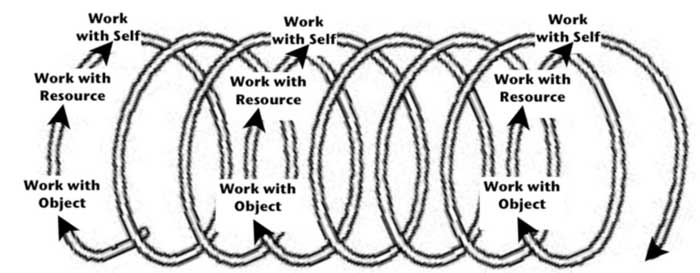
In doing this work over and over again, the Zone of Proximal Development for a learner shifts. All of us in our learning still continue to have a ZPD – it is just the amount that we can handle independently grows.
For more on this framework please check out my post outlining my chapter, “Just want the doctor ordered? Online possibilities for healthcare interpreting education,” in Swabey & Malcolm, ed. In Our Hands: Educating Healthcare Interpreters http://gupress.gallaudet.edu/bookpage/IOHbookpage.html
See More on Online Frameworks for Education
Posted in: Mentoring Resources
Peer Dialogue Process
Peer Dialogue
The button below will take you to a page that describes the Peer Dialogue process (as explained by Patty Gordon) that is used in the Body Language modules with the CATIE Center and other workshops that Doug and Patty are a part of. It is provided in both ASL and English. It is designed to allow you to get the most out of your dialogue with a peer.
Resources on Adult Learning
 Make It Stick – The Science of Successful Learning
Make It Stick – The Science of Successful Learning
from the book’s website:
“To most of us, learning something “the hard way” implies wasted time and effort. Good teaching, we believe, should be creatively tailored to the different learning styles of students and should use strategies that make learning easier. Make It Stick turns fashionable ideas like these on their head. Drawing on recent discoveries in cognitive psychology and other disciplines, the authors offer concrete techniques for becoming more productive learners. “
Posted in: Mentoring Resources
MDE Paperwork & Documents
Educational Interpreter Form
- A form for an Educational Plan you can use in your mentoring. (This is a template. Make a Copy before you use it.)
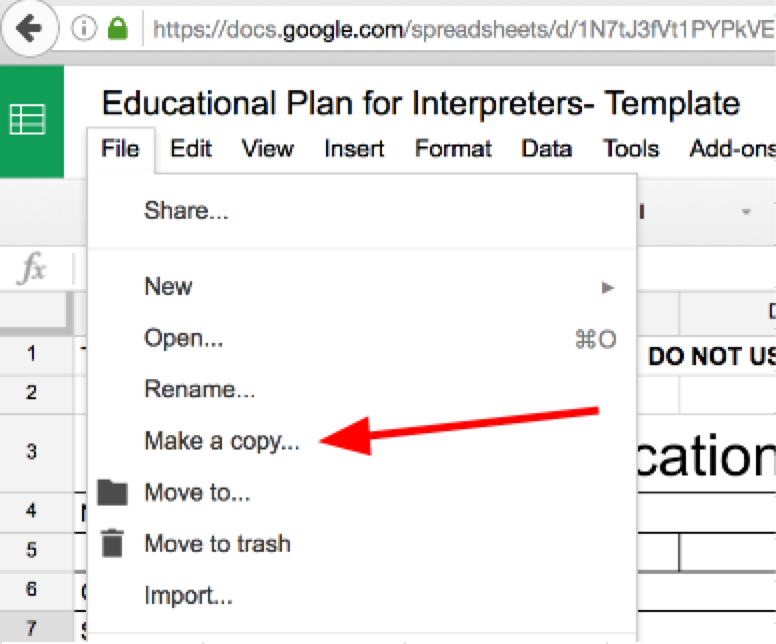
- A Mentorship Agreement Form. (This is a template. Make a Copy before you use it.)
Forms from the Minnesota Department of Education related to Mentoring
- Two-Year Provisional Form for Deaf and Hard of Hearing Interpreters – 9/17/13
Form for two-year provisional certification for interpreters/transliterators working with students who are deaf/hard of hearing. - Request an Extension for an Interpreter/Transliterator – General Information – 9/16/13
This and the following five documents are for an extension to the two-year provisional license for interpreters/transliterators working with students who are deaf/hard of hearing. This document contains due dates and instructions for the letter of intent and Forms A and B. - Request an Extension for an Interpreter/Transliterator -Cover Sheet and Checklist – 9/15/13
Cover sheet and checklist for extension request for interpreter/transliterator - Request an Extension for an Interpreter/Transliterator – Procedures – 9/14/13
Procedures for submission and review of forms - Request an Extension for an Interpreter/Transliterator – Form A – 9/12/13
Form A for extension request for interpreter/transliterator -
b.) Completed by 4 individuals in support of extension:
Print out 4 copies of this document. These must be given to the interpreter/transliterator’s mentor, a parent of the pupil served by the interpreter/transliterator, the special education director of the school district, and a representative from Deaf and Hard of Hearing Services (DHHS). The 4 individuals are to send them directly to MDE so remember to include pre-addressed and postage paid envelopes for them. *The representative at DHHS can change from year to year. The interpreter’s mentor should know who the representative is and if they don’t, contact an interpreter from Step 2 to help figure it out.
Understanding How the EIPA Currently Fits in the QA Law
Educational Interpreter Performance Assessment – 5/19/15
May 8, 2015 memo from Commissioner Cassellius: MDE is examining issues related to interpreters’ scores on the Educational Interpreter Proficiency Assessment (EIPA). Until that work is completed, the commissioner is temporarily lowering the score needed on the EIPA.
Resources from MRID
The MRID Educational Interpreter Committee has also collected a number of these resources and more – including what to do if a district is not in compliance.
Posted in: Mentoring Resources
Case-Conferencing Articles
Here are a list of articles that touch on the importance of Case-Conferencing:
Posted in: "Anatomy of Healthcare Interpreter" Resources, "Anatomy of Medical Interpreter" Resources, "Exploring Emerging Paradigms" Resources, "Finding Your Place" Resources, Case Conferencing Resources, Mentoring Resources
Theory of Mind
Developing a Theory of Mind
Brenda Schick, in a chapter in the book, Educational Interpreting: How It Can Succeed, explains how the developing of a Theory of Mind (ToM) is related to educational development for students and how that can be impacted by receiving schooling through an interpreter. Theory of Mind is defined by Wikipedia as “the ability to attribute mental states—beliefs, intents, desires, pretending, knowledge, etc.—to oneself and others and to understand that others have beliefs, desires, intentions, and perspectives that are different from one’s own.”
Schick argues that an important part of children developing this ability is to see how people talk about certain topics – recognizing that different people will display different emotions. Receiving information through an interpreter can distort the ability to see/hear how other people are conveying information. Based on the EIPA scores of approximately 1,3000 interpreters, she notes the average prosody score for elementary interpreters was 2.8 for elementary interpreters and 3.0 for secondary interpreters. (Many states recognize 4.0 as an overall score denoting being qualified to work in classrooms.) Schick writes of this situation:
Ironically, elementary-aged deaf and hard of hearing children with hearing families, who are likely to be delayed in their Theory of Mind skills and who are still developing their understanding of how minds work, may have the least amount of information in the classroom interpretation to figure out register and identity of the speaker. (pp 77-78)
Interpreters working with students developing a ToM need to be particularly aware of identifying who is speaking in the classroom and providing information about how someone is talking about the topic and what might be the underlying meaning to the message conveyed by the prosodic nature of the discourse. Schick gives the example of a teacher “issuing a warning to finish seatwork by saying ‘It’s getting close to reeecceeesss,’ meaning ‘you may not get to go out if you don’t finish.'” Note that in this example, the teacher’s pronunciation of the word “recess” is elongated giving it a different meaning than is contained by the word on its face. If an interpreter doesn’t include that prosody, then a student would not have access to the actual meaning of the phrase.
So, another important thing for interpreters in educational settings to attend to in helping support the educational development of students who are deaf, deafblind, and hard of hearing.
Schick, B. “Learning through an interpreter,” (pp 73-87) in
 Educational Interpreting: How it Can Succeed
Educational Interpreting: How it Can Succeed
Edited by Elizabeth Winston
View more information on Gallaudet University Press web site.
 Not What You Say, But How
Not What You Say, But How
See a more extended consideration of Theory of Mind and its implications for educational interpreters in a blog post I wrote for MRID. Click here to see the post.
Posted in: "Exploring Emerging Paradigms" Resources, "Part of the Team" Resources, Emerging Paradigm Resources, Mentoring Resources, Sense of Place, Swiss Army Knife Tools
Interpreting Literature
- Shared Reading Project, Gallaudet University
- Visual Language and Visual Learning (VL2) at Gallaudet’s Science of Learning Center
- Classroom interpreting web site (direct link to “Interpreting and children” page) – Boy’s Town
Hop on Pop: English version
Hop on Pop: ASL phonemes
The Story of Ferdinand: ASL sample (From ASL Inside)
To Kill a Mockingbird AudioBook sample
Posted in: "Interpreting Literature" Resources, "TIPS-Light" Resources, Mentoring Resources, Moving toward Best Practice, Sense of Place, Swiss Army Knife Tools
Fingerspelling Resources
- The Importance of Fingerspelling from VL2 at Gallaudet
- The Transition from Fingerspelling to English Print by Tamara S. Haptonstall-Nykaza and Brenda Schick
- Presenting Rare Words by Kevin Williams
On Fingerspelling Tests
Recognizing that the most dynamically equivalent way to represent spoken English in sign language is through rapid fingerspelling, Kevin Williams articulates why this approach is an effective option. That just as hearing students get phonemic clues that they need to put together to actually spell the word, deaf students can get phonemic clues from rapidly fingerspelled words but need to be able to translate those fingerpselled letters into a written word.
Posted in: "Interpreting Literature" Resources, "TIPS-Light" Resources, Mentoring Resources, Moving toward Best Practice, Sense of Place, Swiss Army Knife Tools
Discourse Mapping Resources
Resources for Discourse Mapping
Discourse mapping is a term used for both the process of analyzing texts in interpreter education and skill development and the features of an interpretation that use linguistic features to create a connected and cohesive product. These resources are related to both doing the analysis and being able to create more effective discourse mapping in your work.
Analyzing Discourse: An independent study packet for working with Life in Parallel
This is a packet that takes you through a step by step process for doing discourse analysis.
Navigating Discourse Genres: Canoeing in the BWCA
This video series features a Deaf woman and a hearing man talking about their experiences canoeing in the Boundary Waters Canoe Area Wilderness. There are 6 parallel talks in this topic in the following genres: narrative, procedural, explanatory, hortatory, and argumentative.
Depiction, Blending, and Constructed Action
Miako Rankin, from Gallaudet University, did a workshop on Depiction that provides a good framework on how space is used, how classifiers are incorporated into that, and how depiction of action and conversation is an important framework for helping to understanding the mapping of space and discourse.
Videos for Discourse Mapping
A Source Text for Discourse Mapping Practice
Source Text with Processing Time
Translations without Mapping
To the best of our ability
With Mapping
Slavery and American Revolution
Source Text
No Mapping
With Mapping
Echolocation
The original lecture
With Commentary on Fingerspelling & Discourse Mapping features
A High School Anatomy Lecture
Posted in: "Cartography for Interpreters" Resources, "TIPS-Light" Resources, Discourse Mapping, In Service to Literacy, Mentoring Resources, Moving toward Best Practice, Putting Theory into Practice, Sense of Place, Swiss Army Knife Tools
Demand-Control Schema
Publications
The work by Robyn Dean and Robert Pollard has facilitated a fundamental shift in the interpreting profession from a deontological sense of ethics to a more teleological one. If you are curious about what that means, check out their web site at: Demand-Control Schema
From their web site, you can contact Robyn Dean for the latest information. It is important to recognize that understandings of the Demand-Control Schema is not static. Dean & Pollard are continuing to refine the application of DC-S so be sure to look for the most up-to-date publications and materials.
The latest article from Dean and Pollard which contains the most updated formulation of the Demand-Control Schema in an article format.
Dean & Pollard, 2012. Context-based Ethical Reasoning in Interpreting: A Demand Control Schema Perspective. The Interpreter and Translator Trainer, 5(1) 2011, 155-82.
You can access more of Dean’s publications here.
Webinars & Videos
MARIE Center Webinars
Robyn Dean did a series of webinars in 2014 for the MARIE Center as part of the NCIEC. These are presented in spoken English with captioning and ASL interpretation.
Videos as Part of NCIEC Mentoring Toolkit
Robyn Dean and Bob Pollard created a series of ASL videos explaining the Demand-Control Schema. (These are created in ASL without any English translation.) See those videos under the heading “Robyn Dean.”
Additional Resources
Facebook: get updated information here.
Observation-Supervision: Here’s a blog post from Robyn Dean about the important of developing these groups for observation-supervision.
 Text Book: In 2013, Robyn Dean and Robert Pollard published a textbook on Demand-Control Schema. You can order a copy here.
Text Book: In 2013, Robyn Dean and Robert Pollard published a textbook on Demand-Control Schema. You can order a copy here.
A Resource on Tacit Schemas for Ethical Decision-Making
Rest, J.R., Navarez, D., Bebeau, M., and Thoma, S.J. (1999). Postconventional moral thinking: A neo-Kohlbergian approach. Mahwah, NJ: Lawrence Erlbaum Associates.
Posted in: "Anatomy of Healthcare Interpreter" Resources, "Anatomy of Medical Interpreter" Resources, "Exploring Emerging Paradigms" Resources, "Finding Your Place" Resources, "Part of the Team" Resources, "TIPS-Light" Resources, "Turning on the Light" Resources, Case Conferencing Resources, Emerging Paradigm Resources, In Service to Literacy, Mentoring Resources, Moving toward Best Practice, Putting Theory into Practice, Sense of Place, Swiss Army Knife Tools, Wisconsin Ed Summit, Workshop Resources
Role-Space
The most complete treatment by Robert Lee and Peter Llwellyn-Jones is in their book:
Re-Defining the Role of the Community Interpreter: The concept of role-space. 2014. Lincoln, UK: SLI Press. View on Amazon.
- The presentation from Robert Lee and Peter Llewellyn-Jones from the CIT Conference
- A paper from Supporting Deaf People conference in 2011
- A video explanation in ASL of this concept by Robert Lee – created for the Gallaudet University Regional Interpreter Education Center
Posted in: "Exploring Emerging Paradigms" Resources, "Finding Your Place" Resources, "Part of the Team" Resources, "TIPS-Light" Resources, "Turning on the Light" Resources, Case Conferencing Resources, Emerging Paradigm Resources, Mentoring Resources, Moving toward Best Practice, Putting Theory into Practice, Sense of Place, Swiss Army Knife Tools, Wisconsin Ed Summit, Workshop Resources
Relational Autonomy
 Relational Autonomy – Presentation by Anna Witter-Merithew & Brenda Nicodemus
Relational Autonomy – Presentation by Anna Witter-Merithew & Brenda Nicodemus
Blog Posts on Street Leverage on related topics by Anna Witter-Merithew:
- Sign Language Interpreters: Stepping Out of the Shadow of Invisibility
- Sign Language Interpreters: Are Acts of Omission a Failure of Duty?
- Sign Language Interpreters: Breaking Down Silos Through Reflective Practice
 Nurse Autonomy as Relational by Chris MacDonald (Contact Doug for further information)
Nurse Autonomy as Relational by Chris MacDonald (Contact Doug for further information)
Posted in: "Exploring Emerging Paradigms" Resources, "Finding Your Place" Resources, "Part of the Team" Resources, "TIPS-Light" Resources, "Turning on the Light" Resources, Case Conferencing Resources, Emerging Paradigm Resources, Mentoring Resources, Moving toward Best Practice, Putting Theory into Practice, Sense of Place, Swiss Army Knife Tools, Wisconsin Ed Summit, Workshop Resources
Auslan-Specific Resources
Resources related specifically to Auslan and interpreting in Australia are included here. Thanks to ASLIA-Victoria, vicdeaf, and Sign Language Video Productions for their support in the production of these resources.
Auslan Resources
Auslan Videos with English translations
AUSLAN Resources with English Translations
This page contains both some suggestions for how to work with AUSLAN videos with English translations – as well a list of texts that can be used in this way. Scroll down for links to videos.
Possible Activities:
Working from AUSLAN to English:
- Interpret the video with sound off and blocking captions. It is most helpful if you can record your interpretation to review and reflect on – as well as to compare to the original translation in the next step.To block the captions, simply fold up a sheet of paper and lean it against your computer monitor. Here’s an example:
Original Video
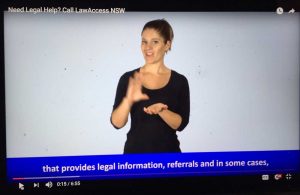
After Covering Captions
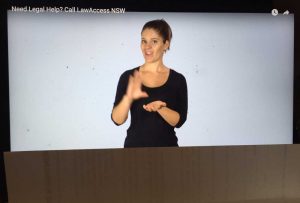
- Listen to the original translation or read the captioned English version. Compare this source to your interpretation in step 1. Note the areas that you were on target as well as the places where your interpretation diverged. What was happening in the video at those points? Does that fit with any patterns that you see in your work?
- Re-Interpret the video with the sound off and captions blocked. Try to incorporate what you learned from Step 2 in your new interpretation. (This is not cheating. This is an opportunity to practice fluency in our work.)
Working from English to AUSLAN:
- Interpret from English to AUSLAN: Listen to the English translation of the video, but don’t watch the AUSLAN version. Interpret this into AUSLAN. Again, it is best to record yourself to assist in analysis and reflection.
- Watch the original AUSLAN version. Compare this source to your interpretation in step 1. Note the areas that you were on target as well as the places where your interpretation diverged. What was happening in the video at those points? Does that fit with any patterns that you see in your work?
- Re-Interpret again using the English translation as source. Try to incorporate what you learned from Step 2 in your new interpretation. (This is not cheating. This is an opportunity to practice fluency in our work.)
The links below have a variety of topics explained in Auslan, with captioning and English translations. Videos formatted in this way are excellent opportunities to practice interpreting in a variety of ways.
These videos were created to be a part of workshops delivered by Doug in Australia
Source without Captions
Original Video (with English captions)
A Visit to Gallaudet
Thanks to Sherrie Beaver for her willingness to share this video. You can see more from Sherrie on her Facebook page, I Sign I Wander.
Visit to Gallaudet – English Translation
This translation was created by Jen Blyth. It is not designed to be the exemplary way to translate the source text, but one approach to be used as a resource for considering how you can create a more effective interpretation than your first attempt.
I am at Gallaudet University, wow, it is beautiful. Me and my friend Pip have had a tour of this university, and it is really beautiful. There is so much history here. Gallaudet is now 152 years old, so much history. I had a look at the buildings and met Gallaudet’s President, Bobbi, I forgot her last name. It was nice to meet her finally, she was a nice woman, we met coincidentally. We also saw the Deaf Space, wow, such an amazing concept. So much history, so many stories. We met an old man who told us about his experience at Gallaudet twenty or forty years ago. While on our tour we saw so many Deaf people around, socialising and talking. This is truly a Deaf space – a ‘Deaf Mecca’, truly wonderful. I always envisioned studying here one day, but I need money! Perhaps I should go to the bank or marry an American person! Look behind me…
A Visit to Gallaudet – Slow Motion
The video has been slowed down to provide a better opportunity for analysis and practice. (It is 80% speed of original video.)
Resources from the Deaf Society New South Wales
These video resources were created to share information in the Deaf community. Because they are formatted with both AUSLAN and English versions, they allow for interpreter skill development similar to practiced in the workshops.
http://deafsocietynsw.org.au/auslan_resources
Posted in: Auslan Resources
Storytelling Resources: AUSLAN – English
Fairytales from Auslan Storybooks
- Goldilocks and the Three Bears
- The Three Little Pigs
- Little Red Riding Hood
- The Gingerbread Man | Aussie Version
- Cinderella
Spoken English Versions
You can use these as a source text if you want to practice from English to AUSLAN – working to incorporate what you saw in the storytelling from Auslan Storybooks.
- Goldilocks and the Three Bears | Another version
- The Three Little Pigs
- Little Red Riding Hood
- The Gingerbread Man
- Cinderella
Posted in: Auslan Resources
Discourse Mapping – Auslan
This series of videos is designed to both learn about the features of discourse mapping and practice incorporating them in your work.
A Lesson on Weather and Climate in Australia
The video above was captioned for accessibility. The original video is at: https://youtu.be/QHn8YGdApOs
Lesson Plan for This Video
Objectives: Successful students will be able to:
- Identify the difference between weather and climate
- Compare and contrast Tropical and Temperate climate zones
- Explain the difference between weather and climate at Uluru in central Australia.


Example Video without Discourse Mapping
This video was created with an attempt to not have discourse mapping feature – which is a significant challenge.
Example Video with Discourse Mapping
This video was created with a more complete range of discourse mapping features.
Year 11 Lecture on Anatomy of a Neuron
You can see a similar process in this post with a lecture on the anatomy of a Neuron.
Posted in: Auslan Resources
Body Language – Auslan
 Body Language – Auslan Style
Body Language – Auslan Style
With the assistance of James Blyth and ASLIA Victoria, vicdeaf and Sign Language Video Productions, we have created a professional development module based on the CATIE Center at St. Catherine University’s successful series of Body Language modules.
The ASL Series has the following topics:
- The Cardiovascular System
- The Digestive System
- The Respiratory System
- The Muscular-Skeletal System
- Dealing with Diabetes
The Auslan version provides a sample activity from each of these 5 modules. Check it out here. We hope that this will be the start of a series of professional development opportunities that can be offered in Australia.
View “Body Language: Auslan” modules
Posted in: Auslan Resources
Parallel Texts – Auslan & English
The following texts are modeled after a resource created by Amy Williamson. She is a heritage signer, growing up with Deaf parents and natively speaking both ASL and English. You can check out Life in Parallel here. In addition, there is a free downloadable study packet entitled Analyzing Discourse. Though designed for an ASL – English resource, the same activities could easily be applied to Auslan-English work.
Australian Parallels
Gratitude to Julie Judd and Michelle Ashley for agreeing to create texts to model this process.
Introductions for Michelle
In this text, Michelle Ashley introduces herself in Auslan and shares some of her professional journey.
In this text, Michelle Ashley introduces herself in spoken English and shares some of her professional journey.
Introductions for Julie
In this text, Julie Judd introduces herself in spoken English and shares some of her professional journey.
In this text, Julie Judd introduces herself in Auslan and shares some of her professional journey.
Julie’s Favourite Thing
In this text, Julie explains in spoken English what her favourite pastime is.
In this text, Julie explains in Auslan what her favourite pastime is.
Michelle’s Favourite Thing
In this text, Michelle explains in spoken English what her favourite pastime is.
In this text, Michelle explains in Auslan what her favourite pastime is.
Posted in: Auslan Resources
Coyotes, Quidditch and Auslan
The following texts are designed to help incorporate narrative and depiction skills in Auslan. Thanks to James Blyth for sharing his storytelling talents.
Suggested Process
Based on Vygotskyan principles, use three steps.
- Create an Auslan explanation of the video clip. (Imagine that you are re-telling what you saw to a Deaf person.) If possible, video your Auslan version. Reflect on what parts went well and what sections were more challenging. Use that reflection to focus your attention in the second step.
- Watch Auslan example of how to convey the video clip. You may want to watch it more than once. On the second time, try copy signing or signing along with the signer to be able to not just see what the signer is doing, but physically incorporate some of the new ideas.
- Re-tell the video’s narrative in Auslan. Think about what you saw in Step 2. Work on incorporating features that you thought were particularly effective. Some might call this “stealing.” In professional development, we call this “learning.”
Talking About Coyotes
Source:
Auslan Example
Source:
Auslan Example
Posted in: Auslan Resources
7th Year Lecture: How the Bear Got Its Tail
This original video comes from a project called “Goats, Trolls and Numbskulls: A Middle School Lecture on Folklore Genres.” Thanks to James Blyth for sharing his talents in Auslan.
Suggestions
- For more background on Lise Lunge-Larsen, the lecturer, and the project as a whole, check out the original resource.
- For maximum benefit, use Vygotskyan framework of three step process:
- Work with object
- Work with Resource
- Work with Self
Source Lecture
Lise explains about this genre and tells the story of “How the Bear Got His Tail.”(3:46)
Auslan Interpretation
Posted in: Auslan Resources
11th Year Lecture: Anatomy of a Cell
This original video was created by a federal grant project. Thanks to James Blyth for sharing his talents in Auslan.
Suggestions
- For maximum benefit, use Vygotskyan framework of three step process:
- Work with object
- Work with Resource
- Work with Self
- Also take time to preview lesson
- Think about the significant features that can contribute to literacy
- Identification of key vocabulary that should be fingerspelled
- Consider what depiction strategies you might use
Preparation Material

Key Vocabulary
In a high school anatomy class, this lesson is focusing on helping students to understand the basic anatomy of a cells and how impulses are relayed within that structure. Included in the lesson are the key vocabulary of:
- cell body
- dendrites
- axon
Source Lecture
This excerpt of the lecture is 1:46.
Auslan Rendition without Discourse Mapping
This version was created for the purpose of showing how a lack of discourse mapping features contributes to a less intelligible text. Thanks for Karen Bontempo for doing the best job possible in removing those features. (As I shared at the workshop in Perth, Karen’s example here is of what not to do – which a participant came up to me and shared how ironic that is because Karen’s work is often lifted up as the model to follow. So grateful that she was also able to provide a model NOT to follow but to learn from in understanding the importance of discourse mapping features.) You can see more on Discourse Mapping in Auslan here.
Auslan Interpretation
See an ASL Version of this activity.
Posted in: Auslan Resources
Healthcare Resources
Here are some resources specific to interpreting in healthcare for Auslan.
- Video Resources from the NABS: This page has a series of videos related to Anatomy and different body systems. Some of the material is in both English and Auslan.
Posted in: Auslan Resources
Linguistics of Auslan
These three videos come from The Linguistics of Auslan page created by deaf CONNECTEd.
The videos use information drawn from the following text:
Johnston, T. & Schembri, A. (2007). Australian Sign Language: An introduction to sign language linguistics. Cambridge: Cambridge University Press.
Posted in: Auslan Resources
In Gratitude
Thanks to the organizations who helped to make this workshop possible.

Thanks to both the WA and Victoria branches for their support and coordination in making Doug’s visit to Australia possible.
Thanks to vicdeaf and their SLVP team that assisted with filming and editing of new Auslan resources.





